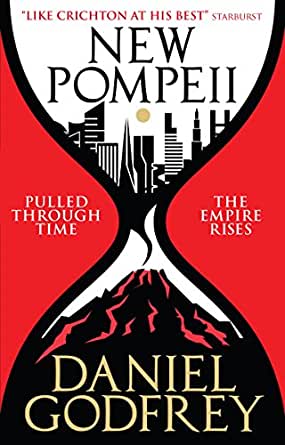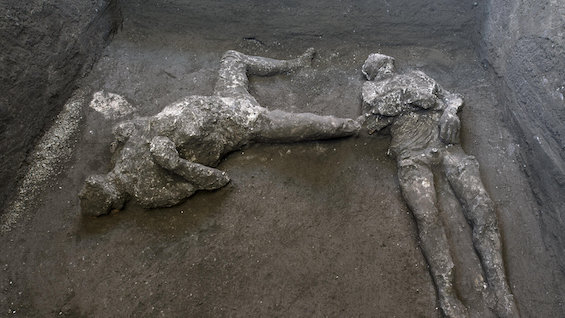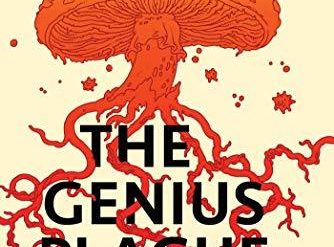
Visits to the past or future have figured in English-language literature since the 18th century. And when H. G. Wells’ classic novel, The Time Machine, appeared in 1895, the trope made its debut in the science fiction genre. For decades, authors simply created stories around the assumption that scientists had figured out how to shift through time at will. Later authors attempted to explain the process by referring to obscure aspects of relativity or quantum theory. More recently, we encounter stories stating outright that “time travel is impossible” but that then proceed to show how it can be accomplished, anyway. Daniel Godfrey’s New Pompeii is one such example. Entrepreneurs in the novel stumble on a potentially lucrative way to bring people from the past into the present—with predictably disastrous results. It’s a new twist on time travel.
From 79 AD to the present
In a brief prologue, we meet Manius Calpurnius Barbatus, duumvir (co-ruler) of Pompeii, and his young adult daughter, Calpurnia. They are cowering in the mounting ashfall from Mt. Vesuvius as it gradually buries their town. Much will happen before we meet them again. But then they will play major roles in this intriguing story.
On one track in the story, a young woman named Kirsten Chapman faces years of terror. She repeatedly finds herself submerged in a bathtub in a locked room, only to be jerked back there soon after she emerges. On the other, major track, a young history graduate student named Nick Houghton faces the ruin of his career. Cutbacks decimate the faculty and fellowship funds at his “third-rate university” in England, and he is certain to lose his stipend. But Nick is not trapped in his depressing reality. For suddenly he finds himself employed by a company called Novus Particles UK LLP, or NovusPart, which has somehow muddled into a way to meddle with the timeline.
New Pompeii by Daniel Godfrey (2016) 352 pages ★★★★☆

A new twist on time travel
We follow NIck to his job with NovusPart in New Pompeii. Somewhere in the vast wastelands of Central Asia, the company has constructed a remarkably accurate replica of Pompeii. It appears as it did shortly after the volcano’s eruption began in 79 AD. And to Nick’s astonishment, they have somehow managed to transport thousands of the town’s citizens and slaves shortly before their deaths in the past. There, as part of the NovusPart team, he plays his role as both historian, to ensure accuracy in the ongoing work of the town’s recreation, and as interpreter. Because NIck speaks both ancient Latin and Greek, and he is uniquely equipped to understand the shifting currents of feeling among the town’s inhabitants. And he will play a crucial part—in fact, the central role—in determining the fate of the company, the town, and its people.
About the author

Daniel Godfrey‘s bio blurb on Google Books reads in entirety: “Daniel Godfrey has had several short stories published, including in My Weekly and Writers’ Forum, and is a dedicated reader of SF and historical fiction. He studied geography at Emmanuel College, Cambridge, and gained an MSc from Leeds in transport planning. Godfrey lives in Derbyshire.” New Pompeii was the first of his four adult science fiction novels. He has also published a children’s book.
For more reading
I’ve reviewed several other novels based in ancient Rome:
- Conspirata (Ancient Rome Trilogy #2) by Robert Harris (Ancient Rome, before the fall)
- Dictator (Ancient Rome Trilogy #3) by Robert Harris (Cicero, witness to history)
- The Silver Pigs (Marcus Didius Falco #1 of 20) by Lindsey Davis (Imperial Rome is the setting for this engaging mystery)
For more good reading, check out:
- These novels won both Hugo and Nebula Awards
- The ultimate guide to the all-time best science fiction novels
- 10 top science fiction novels
- The best time travel novels
- 10 best alternate history novels reviewed here
- Seven new science fiction authors worth reading
- The top 10 dystopian novels reviewed here
And you can always find my most popular reviews, and the most recent ones, plus a guide to this whole site, on the Home Page.

























